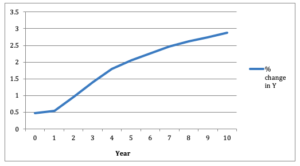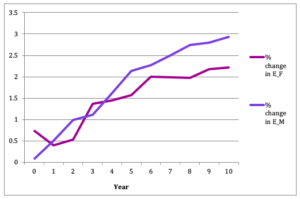Reflections on The Effects of Public Social Infrastructure and Gender Equality on Output and Employment in South Korea
In terms of “Economic Participation and Opportunity” South Korea is one of the lowest-ranked countries in the world (124th out of 149 countries) as of 2018. Global Gender Gap Index also shows that South Korea ranks 88th in terms of female labour force participation and 121st in terms of gender wage equality for similar work. The average wages of women in South Korea are on average 36.7% lower than average male wages (as of 2012, Oyvat and Onaran, 2020). Hence, there is a significant economic gender gap in South Korea despite the fact that the country is now classified as a high-income economy. Moreover, the underdeveloped care infrastructure and reliance on unpaid care labour of women is posing serious demographic and social sustainability challenges in an aging society.
Our new research analyses the effects of public social expenditure in education, health and social care and closing gender pay gap on aggregate output and female and male employment (Oyvat and Onaran, 2020). We introduce a structuralist gendered model of the demand and supply sides of the economy with endogenous productivity, labour supply and wage bargaining. Empirically, we use a structural vector autoregression (SVAR) analysis to econometrically estimate the effects of an increase in social infrastructure spending, female and male wages, and closing the gender pay gap on aggregate output and employment of men and women in South Korea for the period of 1970-2012.
Public social expenditure, specifically education played an important role in the rise of South Korean economy. The social sector has not only been a sector that is crucial for economic growth in South Korea, but it has also been important for generating female employment and closing gender employment gaps. The share of women in employment in the social sector (education, healthcare and social care) has been greater than in the rest of the economy since the 1970s. The share of female employment in the social sector in South Korea increased from 47.4% during the period of 1988-1997 to 58.3% in 1998-2007 and to 63.2% in 2008-2012. In contrast, the share of female employment in the rest of the non-agricultural economy is only 27.7% in 1998-2007 and 28.4% in 2008-2012. The female employment share even in sectors which traditionally had a high female employment such as food, beverages, tobacco, textiles, leather, and footwear or electrical and optical equipment have been steadily declining and is lower than the female employment share in the social sector in the post-1998 period.
Our theoretical framework identifies the possible channels through which public social spending influences total output, male and female employment. In the short-run, the increase in public social spending has a positive effect on total output and female and male employment. While higher social public expenditure may increase public debt/GDP in the short-run, this negative effect is moderated as tax revenues also increase alongside aggregate income, which in turn offsets any potential crowding out effect on private investment. As the female employment share is significantly larger in the social sector than in the rest of the economy, higher public social expenditure is expected to reduce the gender employment gap.
In the medium-run, higher public social expenditure is expected to have not only a direct positive effect on labour productivity, but also an indirect positive effect through i) higher output and benefits of increasing returns to scale; ii) higher wages creating incentives for adopting labour-saving technologies; and iii) higher private expenditure in education, health and social care by the households as income, in particular female income increases. Due to these effects on productivity, we refer to public social expenditure as social infrastructure investment.
Figure 1: The cumulative impact of a 1% increase in social expenditure (YH) on aggregate non-agricultural output (Y)

The estimation results show that a 1% increase in the public social expenditure in South Korea increases non-agricultural output by 0.5% contemporaneously, and by 2.3% in cumulative over six years and 2.9% over ten years (Figure 1). As a result female and male employment increase contemporaneously by 0.7% and 0.1% respectively (Figure 2). The short-run impact is larger for female employment as the share of women is significantly higher in the social sector compared to the rest of the non-agricultural sector. In ten years female and male employment increase by 2.2% and 2.9% respectively. Finally, labour productivity increases by 0.22% over four years.
Figure 2: The cumulative impact of a 1% increase in social expenditure (YH)on female (EF) and male employment (EM)

The results also show that an increase in female wage rate has a significant positive effect on output. A 1% increase in female wages leads to a cumulative increase in output by 0.2% in year 3 and by 0.3% over 10 years. This shows that the South Korean economy is female wage-led/gender equality-led in the medium-run; hence higher equality is conducive to growth and development. The cumulative impact of a 1% increase in the male wage rate on output is 0.2% over 10 years. It is also important to emphasize that higher male wages are not an impediment to growth in South Korea. The results also indicate the importance of improving gender equality as part of an equality-led development policy.
Our research shows that an equitable development path in which both average wages increase and gender gaps close via an upward convergence in the wages of men and women is possible in South Korea. However, the effects from wages are economically small in comparison to the strong effects of social spending. The results indicate that sustainable equitable development and a substantial increase in employment requires a mix of both labour market and fiscal policies.
This blog is authored by Cem Oyvat and Özlem Onaran are both expert researchers for the Care Work and the Economy Project within the Rethinking Macroeconomics working group. To learn more read the CWE-GAM working paper upon which this blog was based here.
- Published in Rethinking Macroeconomics, South Korea
Reflections on Access to Infrastructure, Women’s Time Allocation, and Economic Growth
Despite notable progress in recent decades (including in primary school enrolment and access to the political system), gender gaps remain pervasive in rich and poor countries alike. In many developing economies, gaps in secondary and tertiary education, access to finance and health care, labor force participation, formal sector employment, entrepreneurship and earnings, remain large. In today’s low- and middle-income countries for instance, the labor force participation rate for women is only 57 percent, compared to 85 percent for men. Women’s share in the formal sector employment remains low and in recent years has even fallen in some cases. On average, women workers earn about three-quarters of what men earn. In Sub-Saharan Africa more specifically, women still have fewer years of education and fewer skills than men; and learning gaps remain large. Wage and employment gaps in certain occupations (particularly in managerial positions) and activities, and gaps in access to justice and political representation, also remain sizable.
In recent years formal academic research has shed new light on the causes of gender gaps and their consequences for economic growth. The mainstream analytical literature has identified several channels through which gender inequality may affect growth. One of them is the infrastructure-time allocation channel, which emphasizes the fact that, in addition to the conventional positive effects on factor productivity and private investment, improved access to infrastructure reduces the time that women allocate to household chores, and this may, in turn, allow them to devote more time to remunerated labor market activities. In addition, infrastructure may also have a significant impact on health and education outcomes, for both men and women, which may in turn affect their productivity, relative earnings, and indirectly the allocation of time within the family.
CWE-GAM working paper Access to Infrastructure, Women’s Time Allocation, and Economic Growth further explores how improved access to infrastructure affects women’s time allocation decisions and how, in turn, changes in these decisions affect the process of economic growth in low-income developing countries. To do so it develops a simple two-period, gender-based overlapping generations model with public capital to explore the implications of public infrastructure on women’s time allocation and growth. The focus is on the specific impact of access to public infrastructure services (whose supply can be directly influenced by policy decisions) on female time allocation decisions between market work and home production, and its interactions with economic growth. As in some existing contributions, the basic model accounts not only for the standard productivity effect of public infrastructure but also for its effect on home production and occupational choices. In addition, the case where gender bias and bargaining power, as well as fertility choices and rearing time, are endogenous, and the case where there are two types of infrastructure, physical infrastructure (which includes transport, water supply, and sanitation, telecommunications, and energy) and social infrastructure (which includes the provision of maternal care), are also considered.
The analysis shows that by inducing women to reallocate time away from home production activities and toward market work, improved government provision of infrastructure services—assuming a sufficient degree of efficiency—may help to trigger a process through which a poor country may escape from a low-growth trap. This result is in line with those established in a number of recent contributions. It is also shown that with endogenous gender bias and bargaining power, there are two additional channels through which improved access to infrastructure can affect growth: positive effects on the level and rate of savings, which tends to promote growth. However, the increase in both the public and capital stocks implies that the net effect on the public-private capital ratio, and thus women’s time allocation, is ambiguous in general. This is due to the fact that higher private capital stock increases congestion costs, which tend to lower the public-private capital ratio. By implication, the net effect on gender equality in the market place, and economic growth, is now also ambiguous. Thus, improved access to infrastructure may not always be beneficial.
With endogenous fertility and child-rearing, improved access to infrastructure may raise the fertility rate and total rearing time, thereby mitigating the positive effect on women’s time allocated to market work. However, this effect is not robust. In addition, if there is a positive externality associated with improved access to infrastructure, this may lead not only to a reduction in time allocated to household chores but also to a reduction in total time allocated to child-rearing. In turn, this may lead to women allocating more time to market work, thereby promoting growth. Finally, the analysis highlights the fact that although the physical and social infrastructure is complementary at the microeconomic level, a trade-off exists at the macroeconomic level as a result of the government’s budget constraint. The optimal policy that internalizes this trade-off must account for the relative efficiency of investment in these two types of assets.
This blog is authored by Pierre-Richard Agénor and Madina Agénor who are both expert researchers for the Care Work and the Economy Project within the Rethinking Macroeconomics working group.
- Published in Gender Inequalities, Rethinking Macroeconomics
Reflections on Microfinance and the Care Economy
With rollback of the developmental state under the neoliberal policy regime, financial inclusion has come to be adopted as a developmental strategy. Micro-credit schemes, which were initially promoted as tools for gender-empowerment and poverty alleviation, have in the process become increasingly absorbed within the sphere of mainstream private finance. The relatively low rates of default in this sector have attracted an influx of funds from profit oriented financial institutions. The focus has shifted from the sustainability of income generation for borrowers to that of the profitability of the lending institution. Given the higher transaction costs associated with small loans and extending outreach to marginal low income households this change of focus has undermined the social mission of microfinance to reach the poorest and most neglected households. Social priorities are being subordinated to commercial considerations.
The impact of micro-credit on both poverty and gender relations has been extensively studied. However, the implications of the growth of micro-credit for the care-economy, and their repercussions in the wider macro-economy have received less analytical attention. The neglect of the implication microfinance for the provision of care labor is surprising in the light of the original mission of microfinance, which targeted the female worker in rural areas in developing countries, with less access to earning opportunities and disproportionate responsibility for the care work. The increase in market labor implies a claim on the time of working women. In the absence of social provisioning of care, this claim on the labor time of women could lead to a squeeze on the time of rural working women
A simple two-sector post-Keynesian model allows the integration of the role of demand and care work into the analysis of microfinance. This investigation demonstrates is that micro financed enterprises face a structural constraint on the demand side from overall macroeconomic conditions, and on the supply side from the responsibility for unpaid care work borne by the female beneficiary of microfinance. Paradoxically, microfinance has been espoused as a developmental strategy in precisely the period when the role of the developmental state has been eclipsed, and cutbacks in public spending on care provisioning have been prescribed.
Slowdowns in the wider economy, would lower the demand for the output of the microfinance sector, and hence undermine the viability of these enterprises. The capacity of the microfinance sector to provide the impetus to broader demand growth in the economy is likely to be more limited in the absence of public policies to stimulate demand and investment. The capacity of microfinance to alleviate poverty and lift incomes is thus dependent on conditions in, and linkages with the wider macroeconomy. A vibrant and stable macroeconomy is the only sustainable basis for a stable microfinance sector.
We also draw attention to some of the complexities of the impact of microfinance on the provision of care. The home-based nature of microenterprises perpetuates the gendered asymmetries of care responsibility within the household. While higher female earnings can alleviate the burden of care by making care work more effective and by enabling the market to substitute for unpaid care, at the lower income levels and in a context of the inadequate social provision of care the gendered responsibility for care remains a critical constraint for the female beneficiary of micro-finance.
Some clear policy prescriptions emerge from this investigation. Donors and development agencies have been encouraging raising interest rates in order to ensure the viability and profitability of microfinance lenders. Our model suggests that high-interest rates will actually undermine the scope of microfinance as a path to better and sustainable livelihoods for poor households in rural areas. Higher interest rates in this sector impose a higher burden on the labor time of the female worker with a consequent squeeze of care-labor or the own labor time.
More significantly, the analysis suggests that microfinance cannot be an effective path to poverty alleviation or gender empowerment unless it is backed by investment in the social provisioning of care. The success of microfinance as a developmental strategy depends on wider policies that support demand and the social provision of care. There is, in the final analysis, no substitute for a developmental strategy based on public investment in support of both job creation and social provision of care.
This blog was authored by Ramaa Vasudevan and Srinivas Raghavendran are both expert researchers for the Care Work and the Economy Project within the Rethinking Macroeconomics working group. To learn more read the CWE-GAM working paper upon which this blog was based here.
- Published in Economic Modeling, Gender Inequalities, Rethinking Macroeconomics


